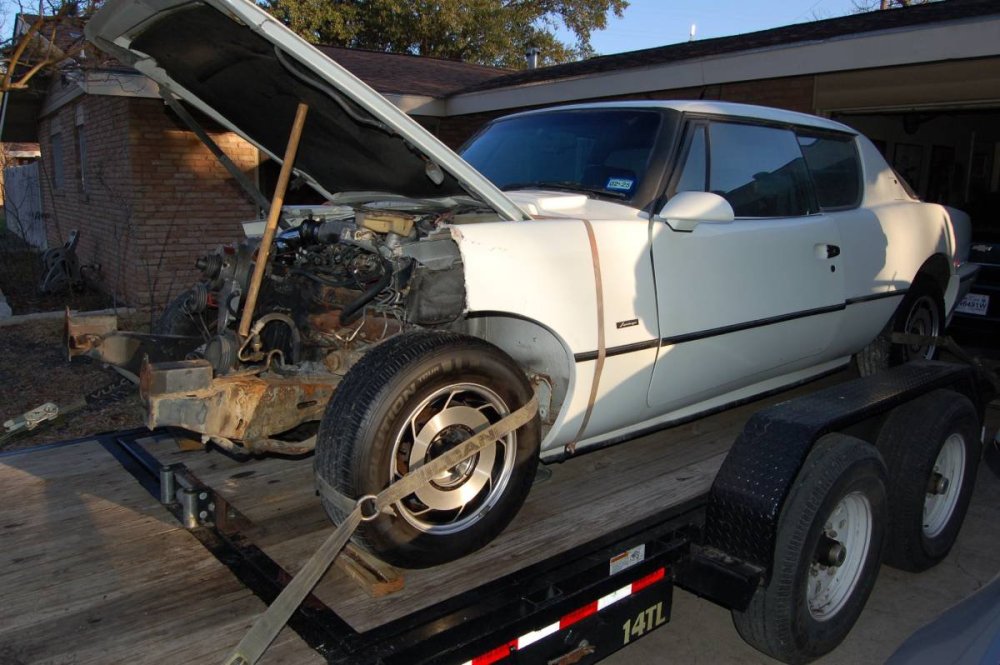
Dwight FitzSimons
AOAI Forum Members-
Posts
641 -
Joined
-
Last visited
Content Type
Profiles
Forums
Events
Everything posted by Dwight FitzSimons
-
AFAIK NOS Strato Vue mirrors haven't been available for decades. The current reproductions are superior to the originals. So, the issue is the screw spacing of the repros, isn't it? --Dwight
-
Nice job. Thanks for posting. This will help others. --Dwight
-
What you're describing is the rear brakes locking up, causing the car to swap ends. In other words, the rear brakes are providing (proportionately) more braking force than the front. But, think about it, if the rears didn't lock up with the Bendix/Dunlop brakes then why would they lock up with the Turner brakes (which provide more braking force than the old disc brakes)? The answer is that they couldn't. You have something seriously wrong. I would go through the complete brake system and make sure that everything is correct. A couple months ago I had my mechanic convert my '64 Avanti's disc brakes to the Turner system, and install his dual master cylinder kit. Everything worked out perfectly and the car has strong brakes that stop the car straight. I am quite happy with Turner's brakes & MC. --Dwight
-
The J-12Y plugs are for an Avanti and are colder than the H-14Y plugs. IIRC the H-14Y are correct for a regular 289 or 259. --Dwight
-
-
Does your Avanti have the optional fast steering? Manual-steering Avantis had a slower steering gearbox (more turns lock to lock) than power-steering Avantis. But, the power-steering gearbox was an option on a car ordered without PS. It was a rare option, but I saw one back when they were new. The quick-steering gearbox, without power assist, would certainly make an Avanti steer hard. The Avanti's production order should list that option, if it was ordered. --Dwight
-
Lots accomplished, finally worthy of a photo
Dwight FitzSimons replied to Hogtrough's topic in Avanti Pub
Thanks for the link. I wouldn't use vinyl dye on a sat-on surface unless that was my only option. The vinyl dye isn't going to crack or anything like that; it'll just gradually wear off. Your seats look great; the Elk color is right on and the covers were well installed. I would guess that those are the seat covers that SI sells. I have those on order. I like your shoulder belts too. That's something I will copy. --Dwight -
Lots accomplished, finally worthy of a photo
Dwight FitzSimons replied to Hogtrough's topic in Avanti Pub
Good job. I'm doing some of the same work on R-4228. You've given me some pointers. I notice that your console has faded, as they tend to do when in the sun long enough. I am going to dye my interior (except seats) using a custom mix of SEM vinyl dye in the Elk color. I went through this years ago successfully. If you want we might be able to collaborate on this. Another issue is a source of the heat-molded pleated vinyl material for the door panels. --Dwight -
Yes, I have seen R2 Avantis fitted with AC. I think people today generally use the Sanden compressor because of its compactness and efficiency. Rogers Protofab advertises in Turning Wheels (SDC magazine) their kit to install the Sanden compressor on an R2 engine. Google can probably find Rogers Protofab. Studebaker mounted the evaporator and all the controls and vents in the console. You would need that out of either a Studebaker Avanti or Avanti II. Or, maybe there is another option for the evaporator & controls. --Dwight
-
How much is a supercharger setup worth?
Dwight FitzSimons replied to Ronny Daytona's topic in 1963-64 Avanti
I don't know. I bought it from a man in South Carolina. It had previously been in New York. I never saw the name Walt Boetcher on any of the documentation. -
How much is a supercharger setup worth?
Dwight FitzSimons replied to Ronny Daytona's topic in 1963-64 Avanti
Not that it matters (also), but I have R-5407, originally R1 and 4-speed, no AC, gray with Claret interior. Now has engine problems and is going into garage for engine repair. Paint (Avanti Maroon) will come later. -
The Best Gasket Co. is alive and well. They specialize in gaskets for vintage engines, including Studebaker & Packard V8s. I recently purchased a complete set for Studebaker V8s and one for Packard V8s. I haven't used either set yet, but they look good. I believe that they have even produced the unique head gaskets for R3 & R4 engines. See their website below. --Dwight https://bestgasket.com/vintage-engine-gaskets/
-
How much is a supercharger setup worth?
Dwight FitzSimons replied to Ronny Daytona's topic in 1963-64 Avanti
The lower compression heads (R2) have a "raised" casting number ending in 582. The higher compression heads (R1 ) have a casting number of 570. This casting number is on the center exhaust outlet on the head. --Dwight -
I have Don's medium-tone stainless-steel mufflers. They are too loud for me, but that is a personal choice. I am going with Walker Dynomax Quiet-Flow mufflers next time. They are relatively quiet, but still low restriction. --Dwight
-
How much is a supercharger setup worth?
Dwight FitzSimons replied to Ronny Daytona's topic in 1963-64 Avanti
I assume the supercharger itself is gone. A core might cost several hundred dollars and a rebuild might be $1000. (Someone who knows more than I do please chime in.) If the supercharger bracket and idler arm are gone then that would be "hundreds" more. Then there is the air horn, air cleaner, and carb. More hundreds. So, assuming those parts are gone it might cost "several thousand $" to put the engine back to R2 status. --Dwight -
How many Avantis are still in existence?
Dwight FitzSimons replied to Ronny Daytona's topic in Avanti Trivia
There aren't any '62 Avantis. All Studebaker Avantis are either '63 or '64 models. The serial number of the first Studebaker Avanti was 63R-1001, and the numbers went up from there. The "63" in the serial number is the model year. It could be that the Avanti you are looking at is an early one sold in the Fall of 1962 and titled as a '62. --Dwight -
In 1963 there was only one front seat style, with either Deluxe or Regal upholstery. In 1964 there were two styles, thin-back and thick back. The upholstery was the same style on both '64 seats. --Dwight So, I did answer your question.
-
In 1963 there was only one front seat style, with either Deluxe or Regal upholstery. In 1964 there were two styles, thin-back and thick back. The upholstery was the same style on both '64 seats. --Dwight
-
Cheap looking wheels?
-
-
Your console is very much faded, but should be Elk, like the rest of the lower "two thirds" of he interior. Studebaker International may have this Elk vinyl dye in a spray can. --Dwight
-
The headliner is white on all 1963-64 Avantis. It looks like yours is a good facsimile of the original headliner. --Dwight
-
Everything above the "beltline" in a '63 Avanti is Fawn color, regardless of the interior color. The roll bar cover is always Fawn in a '63. --Dwight


